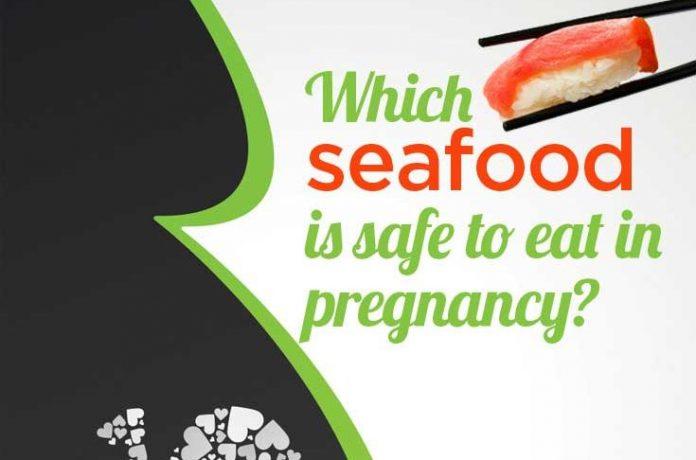 Seafood is a great source of protein for pregnant women. It is low in saturated fat and contains omega-3 oils which may help fetal brain development. However, some types of seafood and methods of preparation may pose a risk to pregnancy. We will look at these risks and show you how you can protect yourself and your baby.
Seafood is a great source of protein for pregnant women. It is low in saturated fat and contains omega-3 oils which may help fetal brain development. However, some types of seafood and methods of preparation may pose a risk to pregnancy. We will look at these risks and show you how you can protect yourself and your baby.
Join the conversation on our discussion boards. Ask questions. Share advice.
Mercury & Pregnant Women
Mercury is a naturally occurring metal found in the world’s oceans. Mercury if consumed in increased quantities can become a neurotoxin for the developing human brain. Some fish, especially larger predatory fish contain amounts of mercury that are unsafe for pregnant women. Consequently, the American College of Obstetricians and Gynecologists and the US Food and Drug Administration have issued guidelines for the types and amounts of fish that can be consumed safely in pregnancy.(1) (2) Their recommendations are as follows:
- Avoid species high in mercury. These are tilefish, shark, swordfish and king mackerel.
- Shrimp, pollock, light canned tuna, tilapia, catfish, and cod are considered low in mercury and may be eaten 2 or 3 times per week.
- Albacore (white) tuna can be eaten up to a quantity of 6 ounces per week.
- If you want to eat fish caught in local streams, lakes, and rivers, check with state or local authorities to find out how much mercury is in those types of fish. If such information is not available limit yourself to 6 ounces per week.
Shellfish
Molluscan shellfish such as oysters, clams, mussels and scallops can be eaten safely in pregnancy if properly cooked. (3) Raw or undercooked mollusks on occasion can contain viruses that cause food poisoning or hepatitis. Therefore pregnant women should not consume raw or undercooked shellfish. Proper cooking of molluscan shellfish means cooking to an internal temperature of 145 degrees F. You don’t need a thermometer because when that temperature is reached oyster, clam and mussel shells will open. Any shells that don’t open should be discarded. Properly cooked crustacean shellfish (lobster, crab, and shrimp) will have an opaque (unable to see through) flesh at 145 degrees F. The same is true for scallops.
Smoked Fish
There have been rare instances of Listeriosis (a serious bacterial infection that can cause fetal death) traced to smoked salmon and other smoked seafood. (1) (4) Therefore, pregnant women should avoid smoked seafood although the absolute risk is very low.
What About Sushi And Sashimi?
The American College of Obstetricians and Gynecologists and the FDA both advise pregnant women not to eat sushi and sashimi made with raw fish. (1) (2) Interestingly, at least two scholarly sources suggest that eating low mercury raw sushi or sashimi handled and prepared properly is about as safe as most other foods that pregnant women eat.(5) (6)
Most raw sushi and sashimi served by reputable restaurants in the United States is prepared from frozen fish. Freezing raw fish to minus 4 degrees F for 7 days or freezing to minus 31 degrees F for 15 hours kills all parasites. (7) The FDA has issued regulations for the safe preparation of sushi and sashimi which reputable restaurants and grocery stores adhere to. (8) If you are sure that your local sushi haunt follows these rules I would consider it safe to eat their sushi and sashimi made from low-mercury raw fish. Obviously you should check with your own obstetric provider before doing so.

The information on this website is designed for educational and/or entertainment purposes only. The information provided is not intended to be a substitute for informed medical advice or care. Please consult a doctor with any questions or concerns regarding your child’s condition. You should not use this information to diagnose or treat any health problems or illnesses.
Works Cited
- American College of Obstetricians and Gynecologists. (2015, April). Nutrition During Pregnancy: Frequently asked questions. Washington, DC, USA. Retrieved June 3, 2015, from Nutrition During Pregnancy
- US Food and Drug Administration. (2014, June). Fish: What Pregnant Women and Parents Should Know. Washington, DC, USA. Retrieved June 3, 2015, from FoodborneillnessContaminants
- US Food and Drug Administration. (2015, May 7). Fresh and Frozen Seafood: Selecting and Serving it Safely. Bethesda, Maryland, USA. Retrieved June 5, 2015, from Consumers
- Jones, JL, Anderson, B, Kirkham, C., & Berkowitz, J. (2010, April). Listeriosis in pregnancy: survey of British Columbia practitioners’ knowledge of risk factors, counseling practices, and learning needs. Canadian Family Physician , 56 (4), pp. e158-66.
- B., Schulkin, J., Parise, M., & Eberhard, M. (2011, March). Sushi in Pregnancy, parasitic diseases-obstetrician survey. Zoonoses Public Health , 58 (2), pp. 119-25.
- Tam, C., Erebara, A., & Einarson, A. (2010, April). Food-borne illnesses during pregnancy: prevention and treatment. Canadian Family Physician , 56 (4), pp. 341-3.
- Live Science. (2012, October 3). Is Sushi Safe to Eat? Retrieved June 4, 2015, from is sushi safe to eat
- US Department of Health and Human Services. (2013). Food Code 2013. Retrieved June 5, 2015, from www.fda.gov: PDF

